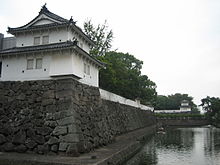|
Funai Domain
Location of Funai Castle   Funai Domain (府内藩, Funai-han) was a feudal domain under the Tokugawa shogunate of Edo period Japan, in what is now southern Ōita Prefecture. It was centered around Funai Castle in what is now the city of Ōita and was ruled by the fudai daimyō Ogyū-Matsudaira clan for most of its history.[1][2][3] HistoryBungo Province was under the control of the Ōtomo clan from the Kamakura period to the Sengoku period. Under the tenure of the Kirishitan warlord Ōtomo Sōrin, the Ōtomo clan invaded Hyūga Province but was defeated by the Shimazu clan from 1586, and were confined to Nyujima Castle (the predecessor of Usuki Castle). The Ōtomo were saved by Toyotomi Hideyoshi's 1586-1587 Kyūshū campaign and were allowed to reclaim Bungo province as their territory. However, Ōtomo Yoshimune (Sōrin's son) behaved in a cowardly manner during the Japanese invasions of Korea (1592–1598) which so angered Hideyoshi that they were deprived of their fief and Ōtomo Yoshimune was banished. Bungo was divided into small fiefs At the Battle of Sekigahara in 1600, Takanaka Shigetoshi, a cousin of the famous Takenaka Hanbei, initially sided with the Western Army and participated in the Siege of Tanabe, but later defected to the Eastern Army, and was rewarded by Tokugawa Ieyasu with an increase in his estates from 10,000 koku in Bungotakada to 20,000 koku in Funai. This marks the establishment of Funai Domain. Shigetoshi's son, Shigeyoshi, succeeded him and gained the favor of Tokugawa Hidetada, but was discovered to have been engaged in illicit foreign trade during the rule of Tokugawa Iemitsu and ordered to commit seppuku. He was replaced by Himeno Yoshiakira from Mibu Domain in Shimotsuke Province in 1634; however on his death without heir in1656 the domain went into attainder. In 1658, Yoshiakira's nephew-in-law (the son of his legal wife's brother), Matsudaira Tadaaki, the daimyō of Bungo Takamatsu Domain was transferred to Funai. Throughout the remainder of the Edo period, the Ogyū-Matsudaira clan continued to rule Funai for ten generations until the Meiji restoration. In 1871, due to the abolition of the han system, Funai Domain became Funai Prefecture, and was later incorporated into Ōita Prefecture. The Ogyū-Matsudaira clan was elevated to the kazoku peerage with the title of viscount in 1884. Holdings at the end of the Edo periodAs with most domains in the han system, Funai Domain consisted of several discontinuous territories calculated to provide the assigned kokudaka, based on periodic cadastral surveys and projected agricultural yields, g.[4][5]
List of daimyō
See alsoReferences
|
||||||||||||||||||||||||||||||||||||||||||||||||||||||||||||||||||||||||||||||||||||||||||||||||||||||||||||||||||||||||||||||||||||||||
Portal di Ensiklopedia Dunia



